Below we present the results based on research and design work from the EduMAP project to create interaction scenarios for enhancing dialogue between the adult education providers and young adults in vulnerable situations to promote adult education (AE) for their active participatory citizenship.
The problem of accessing adult education
Our findings from the Communicative Ecologies (CE) case study reports came to the following conclusions: there are two key barriers to access education and to cultivate active participatory citizenship (APC) competences for young adults from vulnerable groups:
- Low literacies (including media and information literacy) and lack of competences for formal communication, such as finding adult education (AE) opportunities from internet without help or mediating support;
- Lack of connecting networks: many young people are isolated from information or live in isolated communities with lack of access to information. In the absence of connecting networks, they remain unaware of the potential of AE and how to access it.
We also identified a series of leverages and unused potential for enhancing young people’s access to adult education. The data revealed that young adults prefer to use face-to-face guidance, and to some extent personal social networks, as well as in some cases guidance chats for finding education. A significant opportunity to reach out to other vulnerable young adults who could benefit from AE was found to be post-course communication in AE.
Designing the interaction scenarios
The main research question was:
How can forums for dialogue and encounter between AE stakeholders and young people at risk of social exclusion be designed, to improve access and participation in AE programmes?
We generalised the interaction patterns across cases, using the concept mapping technique. Then we developed different narrated stories for the interactions to easier grasp them.
The interaction scenarios were described using the visual approach, accompanied with the narrated design pattern approach developed by Alexander (1977). In the pattern approach each design solution is stated in such a way that it gives essential field of relationships needed to solve the problem, but in a very general and abstract way – the patterns should be used in local contexts by adapting them to local conditions (see the examples below). For a more thorough discussion of the scenarios and the communication design, read the whole report here.
The first interaction path “Communication ecosystem with social media” depicts the overall social media based communicative ecosystem development between different stakeholder organizations and places for secondary information sharing and for increasing the visibility of information about adult education opportunities. This approach enables distributed access to information that is shared in a self-organized manner across the dynamically evolving communicative ecosystem that provides the social media layer. Such information orchestration may support the stakeholder organizations, as well as attract young adults. This practice was more common in countries like UK, Finland and Estonia, while the general trend based on EduMAP case studies is that young adults with NEET, migrant or other vulnerable background with low digital literacy do not utilise such social media channels that the AE and supportive organizations provide.

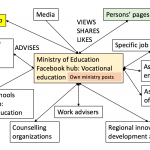
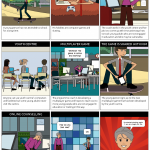
The second interaction path “Hidden advisor” depicts how the advisory practices may be embedded (hidden) into the social media environments, leveraging on the practices among young adults who spend much time in massive multiplayer computer games, at topical forum spaces or groups, or are engaged into serious games through youth centres’ project activities. Such embedded advisory practices have been reported in Finland and Estonia as a way of creating engagement opportunities for some young adults from vulnerable backgrounds. It was also considered a relevant way for first advisory interaction in Greece among young homeless people who do not like to attend social and educational guidance.

The third interaction path “Social facilitator” leverages on the existing advisory practices in different stakeholder organizations, and proposes that advisory engagement in initial stages could be partially conducted using social media channels. This interaction opportunity builds on the finding that advisors were the main information source for young adults with vulnerable background to get to know and access adult education opportunities. The advisory practice as a leverage was common across EduMAP communicative ecology cases.

The interaction opportunity in the fourth case “Alumni network” leveraged on repurposing social interactions in the personal networks of young adults. It was evident from several case studies that while educators keep contact personally with some alumni, and in some cases there is an agreed engagement procedure to follow up with the alumni until a short period after graduation, this practice is still not used as an effective way to gain access to social networks of potential learners to share information about AE learning opportunities. The practice was considered especially useful for accessing young adults with migrant backgrounds.
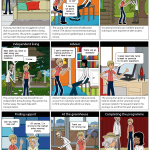
The fifth interaction path “Voluntary help network” was inspired by the emerging social help and sharing economy services that could also be repurposed for providing missing supportive services for young adults to promote their access to AE. In this case, Helpific‘s example was used. The organization provides access to voluntary help networks for finding temporary help, learning buddies, shared transport opportunities etc. for vulnerable people from all age groups. The help is mainly provided free of charge. Helpific has also piloted the interaction path between the people in need, the advisors, and the voluntary helpers. This interaction scenario promotes active citizenship competences among all people taking part, and among vulnerable people themselves, enabling them to offer help to others, such as babysitting, language help, study buddy etc.
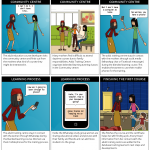
The sixth interaction path “WhatsApp learning group” depicts the emerging educational practices to use social media channels like WhatsApp, Facebook groups or Instagram as digital learning environments for sharing learning resources, tasks, and providing support. The practice was found for example in Austria, Finland, Germany and Turkey. We propose leveraging on that practice to reuse the study groups after graduation as alumni networks.
Application of the scenarios
The scenarios serve as the reference architecture to plan and develop communicative ecosystems in AE in different countries. The following components should be contextually mapped in countries to develop the appropriate country specific design solution.
The main stakeholders’ roles (WHO?): Young adults from vulnerable groups, advisors, communication specialists, educators
The vulnerability of an individual cannot be described by official categories such as NEET, migrant or refugee. Vulnerability associates with complex combinations of cultural, educational, social, economic backgrounds, the passiveness to take part in active life, location, literacy or language constraints and disabilities, gender and digital equality and literacy. For each country, young adults from vulnerable groups should be specified and their media and communication patterns described based on social, information, media layers and agency. Communicative ecologies of similar young adults vary. The trends that affect young adults from vulnerable groups associate with their accessibility: in specific places (like refugee camps, schools); difficulties in identifying their localities (like school drop-outs, long term migrants); according to the services they are accessing (such as people who get social services) and needs (passive young adults from vulnerable groups, with low communication competences, self-regulation and literacy, young adults from vulnerable groups in remote locations). To tailor it to the needs of different young adults from vulnerable groups, the communicative ecosystem needs to have several interaction paths.
Other important roles are those of advisors, communication specialists and educators. In a regional communicative ecosystem, several complementary roles may be needed to support different young adults in vulnerable situations. The orchestrated handling of information, media, and social layers must be achieved between the advisors, communication specialists and educators.
Face to face and digital networks, organizations and physical locations (WHERE?)
The main stakeholder organizations providing advising services, educational services, supportive services should be identified. Some of them have complementary roles. Similar interaction practices with information and media layers must be introduced across complementary roles. For example, how the data of young adults from vulnerable groups can be updated in databases; how to hand over young adults from vulnerable groups between advising, supporting and teaching stakeholders as they progress.
Information, shared meanings and representations, data (WHAT?)
The data about AE opportunities and services must be harvested dynamically. The data of young adults (if tracked along the life path) must be protected, the linked data approaches should be used across different data recording systems to also enable the application of future intelligent decision support engines to be used in providing relevant and tailored AE advice.
Media content and presentation forms about AE should be developed and tailored so that can be used by different platforms and social media channels and cater to different needs.
There could be motivational packages to scale up the access to all young adults in vulnerable situations (e.g. gamified approaches to collect badges, points, achieving small successes through different personalized life paths and by showing responsibility as an active citizen through e.g. mentoring or helping or participating in shared economy based service provision to the others). One of the future features in educational opportunity databases and supportive service databases is the intelligent recommendations tailored to personal needs but also predictive data models.
Media, digital media platforms, data platforms, databases and software (WITH WHAT?)
The growing dependency of corporate controlled social media such as Facebook can be foreseen. The corporate media layer defines the interaction opportunities (free or for a fee) that can be used for advertising AE opportunities with games, promotion campaigns or other means. Separate empirical studies are needed to define the success of such campaigns and games. For example, the harvesting of data from communicative interactions, if implemented in the regional communicative ecosystem for accessing AE could be useful to make evidence based decisions about the effects of actions.
The main pitfalls in agency (resources, literacies) and opportunities to facilitated agency to support the goals (SCAFFOLDS)
The emerging social sharing economy shows potential in providing educational and supportive services through help networks models, increasing the active participatory citizenship competences among young adults from vulnerable groups, and enabling developing informal networks and increasing social cohesion.
Implications
We propose that the design research results – the interaction scenarios for enhancing young adults from vulnerable groups to access to AE opportunities – can be used in various country contexts to develop and orchestrate a communicative ecosystem between different stakeholders and places.
An effective communicative ecosystem may require developing a national database of social services, database of educational opportunities, databases of linked and lifelong records of educational and employment paths and specific needs and accessed services. Using linked records’ data, however, would require decisions and regulations on data access and privacy.
Our analysis demonstrated that there is a need for reliable and professional advisors to promote access to AE for youth in vulnerable situations. These advisors are at present scattered in different organizations such as educational institutions, rehabilitation centres, youth centres, unemployment offices, and migrant centres.
A common procedure for tracking, advice mediation and communication channels needs to be developed in each country’s context that enables different stakeholders in the country to be mutually informed while advising a person. The person should be guided to advisors and to AE opportunities by their preferred ways and channels (such as in physical centres and places, in public social media groups, in personal social media groups, or even in gamified digital environments).
There is a need for activating alumni networks in adult education institutions. This requires rethinking the elements of motivation that could be used to repurpose the AE alumni with vulnerable backgrounds into discovering, mentoring and guiding other young adults with similar backgrounds in need of adult education.
The emerging social sharing economy shows potential in providing educational and supportive services through help network models, increasing the active participatory citizenship competences among young adults from vulnerable groups, and enabling developing informal networks and increasing social cohesion.
The growing dependency of corporate controlled social media such as Facebook is a concern. The corporate media layer defines the interaction opportunities (free or for a fee) that can be used for advertising AE opportunities with games, promotion campaigns or other means. Separate empirical studies are needed to define the success of such campaigns and games.
Text by Kai Pata, comics by Sille Paas and Kai Pata


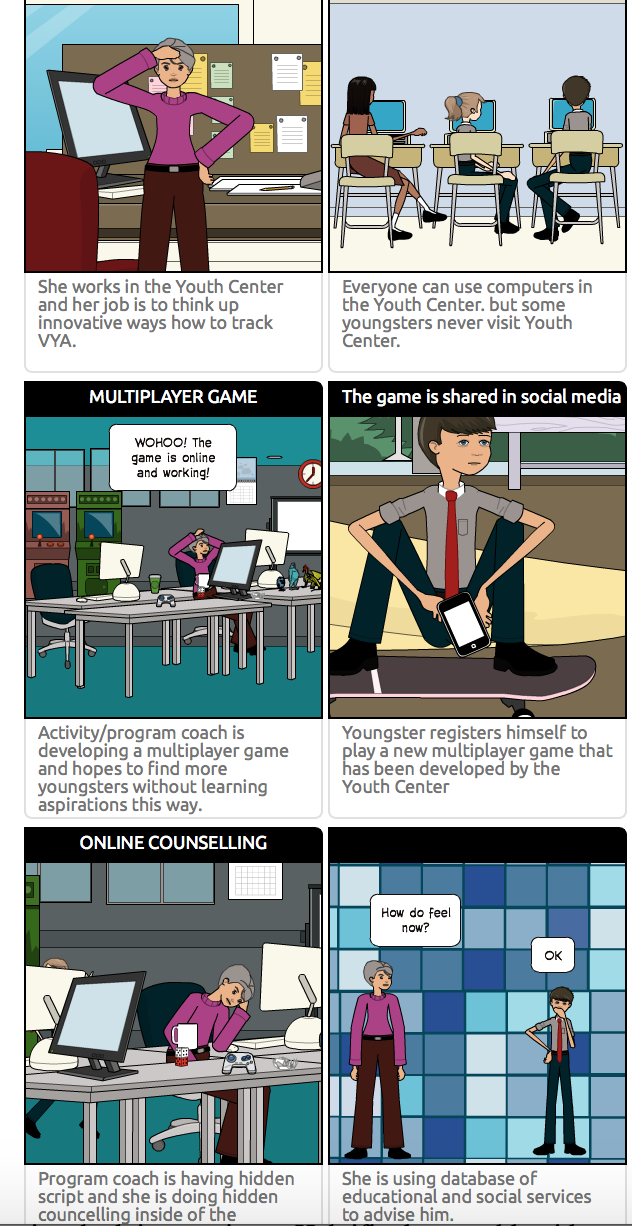
Comments